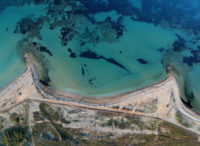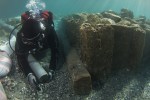 Lechaion, the main harbour town of the rich and powerful city of Corinth at the north end of the strategic isthmus connecting the Peloponnese peninsula to mainland Greece, was a bustling hub of Mediterranean trade from more than 1,000 years (with a brief interruption courtesy of the Roman conquest of Greece in 146 B.C. Julius Caesar had it rebuilt in 44 B.C., and the shinier, bigger Lechaion, aka Colonia Laus Iulia Corinthiensis, got right back to business until it was destroyed in an earthquake in the late 6th century A.D.
Lechaion, the main harbour town of the rich and powerful city of Corinth at the north end of the strategic isthmus connecting the Peloponnese peninsula to mainland Greece, was a bustling hub of Mediterranean trade from more than 1,000 years (with a brief interruption courtesy of the Roman conquest of Greece in 146 B.C. Julius Caesar had it rebuilt in 44 B.C., and the shinier, bigger Lechaion, aka Colonia Laus Iulia Corinthiensis, got right back to business until it was destroyed in an earthquake in the late 6th century A.D.
The harbour structures, including massive ones from the Roman era, have been fully submerged, most of them deep under layers of sand and sediment, ever since and were barely explored despite their historical significance until 2014 when the Lechaion Harbour Project (LHP) took on the long-delayed task of surveying the site. The Greek Ephorate of Underwater Antiquities, the University of Copenhagen and the Danish Institute at Athens have been collaborating on this ambitious project, sending teams of marine archaeologists to explore the physical ruins and geologists with the latest scanning technology to detect the buried remains that can’t be seen.
 In 2015, LHP researchers discovered extremely rare surviving remains: large sections of six wooden barges, a total of 187 feet of wood, used as caissons to protect the harbour from heavy wind, surf and sedimentation. The warm brine of the Mediterranean is a welcoming environment for woodworm which can reduce timbers to nothingness in weeks. The odds of finding organic remains of any kind from thousands of years ago, never mind on so grand a scale, are vanishingly small. It gave rise to the hope that the team might someday find actual ship remains, maybe even a trireme, much sought but never found.
In 2015, LHP researchers discovered extremely rare surviving remains: large sections of six wooden barges, a total of 187 feet of wood, used as caissons to protect the harbour from heavy wind, surf and sedimentation. The warm brine of the Mediterranean is a welcoming environment for woodworm which can reduce timbers to nothingness in weeks. The odds of finding organic remains of any kind from thousands of years ago, never mind on so grand a scale, are vanishingly small. It gave rise to the hope that the team might someday find actual ship remains, maybe even a trireme, much sought but never found.
No trireme has turned up yet, but this season’s archaeological survey has found more organic material, including a worked wood post in jaw-dropping condition, seeds, nuts, twigs, fruit pits and bones. The caissons were part of two Roman-era monumental piers, dubbed Mole L-M1 and Mole L-M2, whose massive stone block are the only remains of the Outer Harbour still visible just above the water line.
“During the 2017 excavations, the first Roman-period harbour structures at Lechaion have come to light. The mysterious island monument in the middle of Harbour Basin 3 – an area of the Inner Harbour measuring 24,500 m2 – was dated to the early 1st century AD. It was likely built as part of a Roman building program designed to help restore Corinth, just as the enormous 45 metres long, 18 metres wide and 4 metres high mole was constructed on exactly the same orientation as the mysterious island monument. Also, we identified a new roughly 40.000 m2 large harbour basin in the Outer Harbour (probably 6th century AD), another 40.000 m2 basin in the Inner Harbour dated to the mid-1st century AD, and the possible foundation for a lighthouse,” reports University of Copenhagen archaeologist Bjørn Lovén who co-directs the Lechaion Harbour Project.
“We have excavated archaeological layers where almost everything is preserved. Consider the pristine preservation of the roughly 2000-year-old wooden post (see video) and imagine how well-preserved wood and other organic materials that still lie at the bottom of this harbour,” says Bjørn Lovén.
The wooden post probably served as either a part of the foundations for the structure itself or perhaps as a bollard for mooring ships. The team also unearthed a variety of seeds, bones with cut marks, a roller from a wooden block, and fragments of worked wood.
“As a part of our research the Centre for GeoGenetics will extract and analyse the ancient environmental DNA from the important archaeological deposits and attempt to reconstruct the past environment genetically. Recently, they have shown that ancient DNA in deposits can identify a wide variety of organisms, everything from bacteria to plants and animals. Hence, they will characterise what lived in the area of Lechaion during the various phases of Antiquity, including the Roman period. We are discovering everything from DNA evidence to monumental moles constructed of five-ton blocks,” concludes Lovén.
This video has some phenomenal footage of the moles from above and under the water, including shots of mud lines and trident marks carved into the massive five-ton blocks, plus the island monument in the Inner Harbour and its glossy golden wooden post.